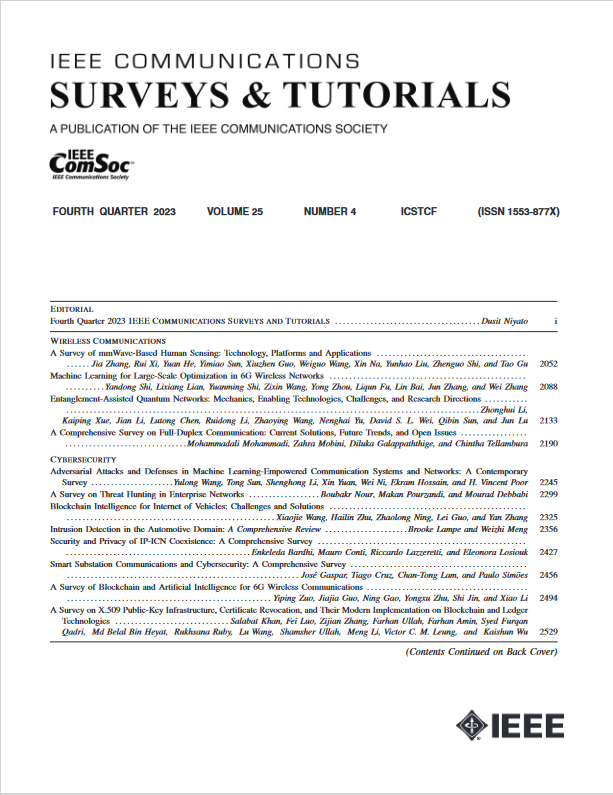面向深度学习的端到端云协同计算:全面调查
IF 34.4
1区 计算机科学
Q1 COMPUTER SCIENCE, INFORMATION SYSTEMS
引用次数: 0
摘要
深度学习应用和服务的蓬勃发展在很大程度上依赖于云端的大型深度学习模型和海量数据。然而,基于云的深度学习在满足响应性、适应性和可靠性等应用要求方面遇到了挑战。基于边缘和终端的深度学习可实现快速、近乎实时的分析和响应,但边缘节点和终端设备通常资源有限,无法支持大型模型。这就需要整合终端、边缘和云计算技术,将它们的不同优势结合起来。尽管已有大量关于边缘与云计算协作的研究,但仍需要对终端边缘云计算支持的深度学习进行全面调查,以回顾现状并指出未来方向。因此,本文1)分析了端-边-云计算系统中深度学习的协作要素,提出了端-边-云协作框架下深度学习模型的协作训练、推理和更新方法与机制。2)系统研究了端-边-云协同深度学习的关键使能技术,包括模型压缩、模型分区和知识转移。3)强调了六个开放性问题,以激励端-边缘-云深度学习领域的持续研究工作。本文章由计算机程序翻译,如有差异,请以英文原文为准。
End-Edge-Cloud Collaborative Computing for Deep Learning: A Comprehensive Survey
The booming development of deep learning applications and services heavily relies on large deep learning models and massive data in the cloud. However, cloud-based deep learning encounters challenges in meeting the application requirements of responsiveness, adaptability, and reliability. Edge-based and end-based deep learning enables rapid, near real-time analysis and response, but edge nodes and end devices usually have limited resources to support large models. This necessitates the integration of end, edge, and cloud computing technologies to combine their different advantages. Despite the existence of numerous studies on edge-cloud collaboration, a comprehensive survey for end-edge-cloud computing-enabled deep learning is needed to review the current status and point out future directions. Therefore, this paper: 1) analyzes the collaborative elements within the end-edge-cloud computing system for deep learning, and proposes collaborative training, inference, and updating methods and mechanisms for deep learning models under the end-edge-cloud collaboration framework. 2) provides a systematic investigation of the key enabling technologies for end-edge-cloud collaborative deep learning, including model compression, model partition, and knowledge transfer. 3) highlights six open issues to stimulate continuous research efforts in the field of end-edge-cloud deep learning.
求助全文
通过发布文献求助,成功后即可免费获取论文全文。
去求助
来源期刊

IEEE Communications Surveys and Tutorials
COMPUTER SCIENCE, INFORMATION SYSTEMS-TELECOMMUNICATIONS
CiteScore
80.20
自引率
2.50%
发文量
84
审稿时长
6 months
期刊介绍:
IEEE Communications Surveys & Tutorials is an online journal published by the IEEE Communications Society for tutorials and surveys covering all aspects of the communications field. Telecommunications technology is progressing at a rapid pace, and the IEEE Communications Society is committed to providing researchers and other professionals the information and tools to stay abreast. IEEE Communications Surveys and Tutorials focuses on integrating and adding understanding to the existing literature on communications, putting results in context. Whether searching for in-depth information about a familiar area or an introduction into a new area, IEEE Communications Surveys & Tutorials aims to be the premier source of peer-reviewed, comprehensive tutorials and surveys, and pointers to further sources. IEEE Communications Surveys & Tutorials publishes only articles exclusively written for IEEE Communications Surveys & Tutorials and go through a rigorous review process before their publication in the quarterly issues.
A tutorial article in the IEEE Communications Surveys & Tutorials should be designed to help the reader to become familiar with and learn something specific about a chosen topic. In contrast, the term survey, as applied here, is defined to mean a survey of the literature. A survey article in IEEE Communications Surveys & Tutorials should provide a comprehensive review of developments in a selected area, covering its development from its inception to its current state and beyond, and illustrating its development through liberal citations from the literature. Both tutorials and surveys should be tutorial in nature and should be written in a style comprehensible to readers outside the specialty of the article.
 求助内容:
求助内容: 应助结果提醒方式:
应助结果提醒方式:


